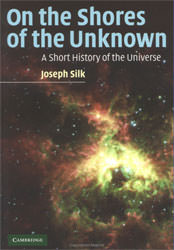
Our universe has been around a long time, nearly 15 billion years. Before that, who knows? Maybe there were strings or branes in existence. During the pre-Big Bang, these might have flexed in unison and produced a singularity of infinite density. Highly speculative as this beginning is, the follow-on is much more understandable and verifiable. Theories elucidate happenings at about 10-43 seconds after the Big Bang or time zero. These, together with knowledge built up from peering deep into the smallness of matter, help build a picture of baryons coming into being, forces starting to push and pull, and protons and neutrons appearing and making the common matter which we are most familiar with today. From this description of the small, the universe went on to make the big – the stars, galaxies and clusters. As with anything else, the common denominator of the universe is perpetual change over time.
Trying to unravel this mystery of galactic evolution is, as Silk writes, as challenging as archaeologists piecing together life from eons ago. However, instead of deducing an environment from a few bone fragments, cosmologists must interpret emissions scattered about the electromagnetic spectrum. These emissions result from a variety of processes and give clues to the universe’s history. Thus, cosmologists will postulate various models and theories on causes and effects. Nevertheless, as Silk points out, proving any of these is next to impossible as we just can’t emulate a universe in a laboratory. What we can do to solve the mystery is to piece together clues found through experimentation and observation.
Given this vague data set, anyone would be right in assuming that one cosmological theory is as good as another. Silk, however, mostly chooses one route for his history and only occasionally considers alternative theories. His route starts with the Big Bang, is followed by a very short, rapid inflationary period that then morphs into the slower inflationary period of today’s universe.
The strength of Silk’s book is that he continually makes links between theories and experiments. Visual observations, neutrino observatories and detectors in particle accelerators all bring facts into the theories. For example, the concentration of heavy metals differs amongst stars. Yet the concentration of heavy metals is directly associated with age, hence, we can estimate a star’s age and thus the age of the surrounding galaxy. Further, by looking at various red shifts, we can estimate rotational velocity and this, together with a bit more finesse, will determine the velocity with respect to the centre of the universe. Or, there is the Wilkinson Microwave Anisotropy Probe that measures the background temperature fluctuations to implicitly define the distribution of matter today. Silk even provides links into future tests, such as the Laser Interferometer Space Antenna scheduled to detect ancient gravity waves after launch in 2012. By clearly identifying the role of various future and recent experiments, Silk enables the reader to readily come to grips with our understanding of the cosmos today and our targets for more knowledge tomorrow.
Silk ably portrays highly technical knowledge in fine writing. Sometimes his book reads like a compressed graduate text with little pause for clarification or repetition. He has a somewhat higher than average expectation of prior knowledge. There are no equations, nor questions at the end of a chapter, but they might well have been there in an earlier draft. As such, the reader should be comfortable with the more esoteric concepts of cosmology in order to get the most from this short history of the universe. Mind you, with the many graphs and diagrams, the reader does have plenty aids in grasping the concept. Further, a number of colour plates dramatically demonstrate the processes being discussed.
If you want to know why we do certain astronomy experiments or why we believe in certain cosmological principles, Joseph Silk’s book On the Shores of the Unknown is just what you need. From the creation of matter to the formation of galactic clusters, he provides a clear, soundly reasoned exposition of how a point of infinite density could have made us into what we are today. With this, we can certainly consider making big plans for tomorrow.
Review by Mark Mortimer
Read more reviews online, or purchase a copy from Amazon.com.
